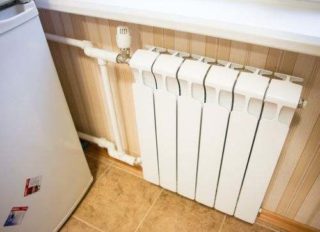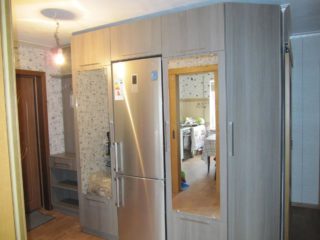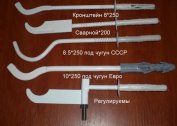If the kitchen has a small area, arranging furniture and household appliances in it can be a big problem. It is especially difficult to find a place for bulky objects that have no place in the nursery, bedroom and on the balcony. Many people put a refrigerator next to a heating battery, not interested in the consequences of such a decision. In order not to create major financial troubles for yourself, you should familiarize yourself with the general arrangement of freezing equipment, the rules for its placement and operation.
Consequences of placing a refrigerator near a battery
The refrigerator is a large insulated cabinet, inside of which refrigerant runs through the tubes, due to which the food is frozen. On the rear panel there is a radiator and a compressor responsible for cooling the liquid carrier. The motor is in the tank and cools due to the constant flow of fluid from the inner chamber. To ensure that the working bodies do not overheat, a technological gap is provided between the rear wall of the refrigerator and the adjacent surface, which is 8-10 cm for different models.
If you install a refrigerator near a battery, the consequences may be as follows:
- The compressor will work continuously, as it will heat up from the radiator. Hot air prevents the cooling of the motor, which leads to its combustion.
- The radiator will not be able to remove the heat produced by the equipment. To achieve a predetermined temperature in the chamber, the engine will operate at maximum load, which will lead to increased energy consumption.
- Since the batteries are installed in a niche under the window, there will be problems with access to its wings. In addition, part of the window opening will be closed, which will make the room darker. This will also negatively affect the interior, where the windowsill, curtains and street landscape play an important role.
- Lowering the temperature in the kitchen. Since the refrigerator will block part or all of the battery, its heat will be blocked, and heated air will rise to the ceiling.
- Ice formation in the freezer. This happens when there is an arrangement of the equipment with a side wall to the heater. The result is spoilage of products and their loss of presentation. The freezer will need to be cleaned more often, since a mass of ice deforms the tubes.
The idea of installing a refrigerator near a battery is losing in every way. Expensive equipment can become unusable in a matter of days. Free repair under warranty will be refused, since all manufacturers in the instructions for use indicate the inadmissibility of placing refrigerators near heating appliances.
Accommodation conditions and the required distance
The user manual states that the minimum distance from the refrigerator to the battery should be at least 50 cm. This applies not only to heating radiators and piping. A stove is equated to heaters. In the process of cooking or heating food, it emits a large amount of thermal energy, which spreads to the sides, reflected from the bottom of the dishes. Because of this, the side walls of the unit are heated. Suppose that there are no tubes with Freon, but the heat is transferred to the chamber, due to which a more frequent relay operation occurs, electricity consumption increases and equipment wear is accelerated.
Do not forget about the sun.It is able to heat the refrigerator much more than all household appliances combined. Based on this, you need to place the freezer so that as little sunlight as possible gets on it.
When choosing a place to install the refrigerator, you should adhere to these rules:
- Do not put the equipment close to the wall or furniture. It is necessary to use the stops that the manufacturer places in the packaging box. Clearance is necessary for the flow of cold air to the radiator and compressor unit.
- Raise the unit as high as possible above the floor. For this, adjustable legs are used. Due to this, the ventilation of warming parts will occur more efficiently, water will not get on the bottom during wet cleaning in the kitchen or leaks.
- If you can not maintain the recommended distance between the refrigerator and the battery, you need to use insulation materials. The simplest option is drywall or thin foam. It is even better to use rolled or tile insulation made of foamed polyethylene. This is an environmentally friendly material with low thermal conductivity and the absence of harmful emissions when heated.
- Do not place electrical elements of the “warm floor” system in the place where you plan to put the refrigerator. This is equally harmful for both products. They will overheat, which will lead to breakage and costly repairs.
A radical solution to the problem is to turn off the battery or isolate it with a heat insulating material that completely absorbs the released energy. In this case, you have to decide another question: how to heat the kitchen. It is not difficult to get out of the situation, as modern industry produces many models of compact household heaters of wall, floor and even ceiling type. These are additional costs, but they are much less than regular purchases of new refrigerators instead of burned ones.
Proper location in the kitchen
There are many furniture companies ready to make a kitchen corner to order in accordance with any customer requirements. If we are talking about arranging a small room, it makes sense to use the services of a designer. The specialist uses computer programs with which even complex planning problems are solved. With a competent approach, there is a place for everything: a refrigerator, a stove, a dishwasher, a table, cabinets and cabinets.
The following options for placing freezing equipment in the kitchen are considered optimal:
- In one of the corners from the side of the window. There, the equipment will be protected from direct sunlight and exposure to warm air when airing in the summer. As for the proximity of the heating radiator, the issue is easily solved by installing a decorative partition or gluing the side of the device with heat-insulating material, followed by decorating with adhesive film.
- By the wall next to the front door. This is an ideal position for a refrigerator. There will be no objects on the sides of it, so that air does not block access to the radiator and compressor. The dining table can be moved to the window, and instead of benches to use chairs, pushed under the table.
- In the corner opposite the window. This is a good solution not only from a technical point of view, but also in terms of planning the configuration of the headset. The side of the unit will become the starting plane, from which calculations of the sizes of cabinets, cabinets, sinks and aprons will be made.
A creative approach will allow you to properly install a refrigerator even in a kitchen with a small area. You can find a place for equipment yourself. To do this, use paper patterns cut to scale.
Alternative installation options
If you have tried all the options and the free area remains only next to the battery, do not rest against this version. It gives only a temporary way out of the situation, sooner or later it will have to be abandoned. The reason for the refusal will not be the most pleasant, as it will result in a breakdown in the refrigerator. It is better not to take the circumstances to such an extreme, but initially find an alternative solution.
- Adjacent pantry. If the unit does not fit completely in it, it is enough to remove the door, and cover the remaining slots with false panels.
- Living room. If the room is not used as a living room, the sound of a running compressor will not hurt anyone. Adapt the refrigerator to the interior will help gluing film or decorative staining.
- The corridor. With a sufficiently large area of the room, the unit will not interfere with the free passage of people. It is even better to hide it in a closet, not forgetting about natural or forced ventilation.
- Insulated loggia (no balcony). These premises, due to their design, are designed for heavy loads. The main thing is that the temperature in the loggia does not fall below + 5ºС.
The choice of places for installing the refrigerator is quite extensive. Priorities are created individually based on the conditions of each apartment.






